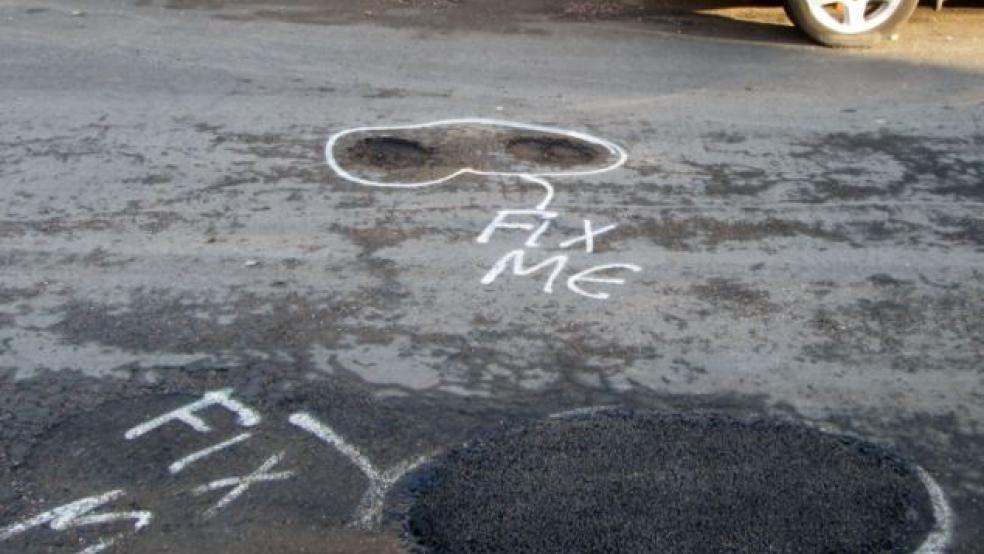Just when the construction industry appeared to be getting back on its feet, the threat of a government highway funding crisis this summer has city and state officials and industry leaders on high alert.
Many states have already blown their budgets for this year trying to fill all the potholes created by one of the worst winters in memory. “It doesn’t matter how many big projects you have planned when your citizens are driving through potholes,” said Leslie Wollack, the National League of Cities’ program director for federal relations. “That is what people tend to focus on. But I think cities are worried quite a bit about what the future holds.”
The federal highway trust fund used to finance more than $50 billion of highway and bridge construction annually. Now, as the summer months approach, the fund will run out of money unless the Obama administration and Congress agree to new transportation legislation.
Related: Obama Looks to Tax Reform to Save America’s Highways
Those federal funds constitute nearly two thirds of all government highway transportation spending and are the lifeblood of tens of thousands of construction companies and suppliers and nearly 600,000 workers across the country, according to industry estimates. Unless Congress finds a way to avert a looming bankruptcy of the highway trust fund, President Obama warned recently in St. Paul, Minn., “We could see construction projects stop in their tracks, machines sitting idle, workers off the job.”
“We’re looking at a crisis and it’s coming sooner than most people realize,” said Ken Simonson, chief economist for the Associated General Contractors, which represents 26,000 companies.
The construction industry arguably was the hardest hit by the Great Recession, as the new housing market collapsed and state governments, businesses and individuals postponed new construction projects. The number of business establishments in construction declined 7.8 percent and the number of employees declined 15.3 percent between 2008 and 2009.
In the last few months, the industry has begun to bounce back, thanks to a housing market that’s recovered from record low. At the same time, many non-residential building markets are starting to turn the corner, making for many optimistic forecasts for 2014.
Related: American Infrastructure Gets a New Wakeup Call
In February, employment in construction rose modestly by 15,000 jobs, according to the new Labor Department released on Friday. Over the past year, construction has added 152,000 jobs.
While the government’s mounting highway and bridge spending woes may not be enough to set the economy back on its heels, it could impose serious hardship on businesses and construction crews just when it looked as if the industry had turned the corner.
“We are hearing this increasing sense of panic in terms of what will happen with the trust fund, and it’s not as if we have that much time for extensions,” said Wollack.
Even before this winter, more than a quarter of the nation’s major urban roads– interstates, freeways and other arterial routes – had pavements that were in substandard condition and provided an unacceptably rough ride to motorists, costing the average urban driver $377 annually, according to a study last year by TRIP, a transportation research and lobbying group.
The nationwide annual cost of driving on deteriorated roads – including flat tires, broken axles, damaged suspension systems and so forth, is at least $80 billion. And pavement conditions are likely to worsen under current funding by all levels of government.
“The challenge is that approximately three quarters of state and local governments have spent more than they normally do on winter road maintenance,” said Rocky Moretti, director of policy and research for TRIP. “Most funds come out of the same fund that are used to do routine road repairs, so you’ve got worse damage than normal and less money to address them.”
Related: Obama’s Big Pitch for Infrastructure Falls Short
For years, federal officials have propped up the federal highway trust fund that finances the maintenance and rebuilding of an aging U.S. transportation infrastructure using revenues from a federal tax of 18.4 cents per gallon on gasoline and 24.4 cents per gallon on diesel.
But far more money has been going out than coming in, as changing driving patterns and fuel efficiency have cut back on the federal fuel tax revenues. The U.S. Department of Transportation estimates the highway construction trust fund will go belly-up later this year – likely in August.
“The day the Treasury says that the highway account has slipped below whatever they say is needed for daily balance, they’re going to hold up payments,” said Simonson of the Associated General Contractors. “That will be a real crisis for contractors and their employees and suppliers.”
Obama recently unveiled a proposal for a $302 billion, four-year transportation infrastructure legislation package that would increase highway construction funding by 22 percent a year, boost mass transit spending by nearly 70 percent annually, and provide nearly $5 billion a year for high performance and passenger rail programs.
Instead of seeking an increase in the federal gasoline tax – a political non-starter in an election year – Obama would use corporate tax reform to generate a $150 billion infusion of tax revenues into the troubled highway trust fund over a four-year period.
But the prospects of Congress and the administration agreeing on major tax reform this year, with important midterm elections on the horizon, are next to zero. And there is apparently no appetite in Congress to raise the federal gas tax. Simonson dismissed the Obama plan as “somewhat disingenuous” and “hard to take seriously.”
So the most likely solution would be an agreement this spring to transfer enough money from the general fund account or elsewhere to keep highway projects from falling through a sink hole.
Top Reads from The Fiscal Times:





